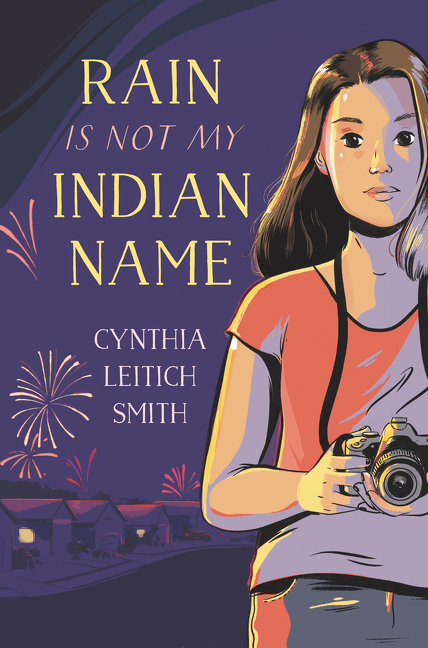
Book Resume
for Rain Is Not My Indian Name by Cynthia Leitich Smith
Professional book information and credentials for Rain Is Not My Indian Name.
See full Book Resume
on TeachingBooks
- Publisher's Weekly:
- Ages 10 - 14
- School Library Journal:
- Grades 5 - 9
- TeachingBooks:*
- Grades 5-12
- Word Count:
- 30,907
- Lexile Level:
- 860L
- ATOS Reading Level:
- 5.8
- Cultural Experience:
- American Indian
- Genre:
- Realistic Fiction
- Year Published:
- 2001
12 Subject Headings
The following 12 subject headings were determined by the U.S. Library of Congress and the Book Industry Study Group (BISAC) to reveal themes from the content of this book (Rain Is Not My Indian Name).
- Juvenile Fiction | Social Themes | Death, Grief, Bereavement
- Death--Fiction
- Photography--Fiction
- Indians of North America--Fiction
- Photography
- Children's Books/Ages 9-12 Fiction
- Grief--Fiction
- Death
- Grief
- Juvenile Fiction | Social Themes | Adolescence & Coming of Age
- Juvenile Fiction | People & Places | United States - Native American
- Indians of North America
4 Full Professional Reviews
The following unabridged reviews are made available under license from their respective rights holders and publishers. Reviews may be used for educational purposes consistent with the fair use doctrine in your jurisdiction, and may not be reproduced or repurposed without permission from the rights holders.
Note: This section may include reviews for related titles (e.g., same author, series, or related edition).
From Horn Book
January 1, 2002
Fourteen-year-old Rain, of mixed Native American heritage, is devastated by her best friend's death. She comes out of her self-imposed seclusion to shoot photos for a local newspaper feature on a summer youth program for Native Americans in her Kansas hometown. The engaging first-person narrative convincingly portrays Rains grieving process and addresses the varying degrees of prejudice she encounters.
(Copyright 2002 by The Horn Book, Incorporated, Boston. All rights reserved.)
From Publisher's Weekly
July 9, 2001
Multiple plot lines and nonlinear storytelling may make it difficult to enter Smith's (Jingle Dancer) complex novel, but the warmth and texture of the writing eventually serve as ample reward for readers. The sensitive yet witty narrator, 14-year-old Cassidy Rain Berghoff, grows up in a small Kansas town as one of the few people with some Native American heritage. That experience alone might challenge Rain, but Smith creates a welter of conflicts. Rain's mother is dead (she was struck by lightning), and as the novel opens, her best friend is killed in a car accident just after he and Rain realize their friendship has grown into romance. Six months later, her older brother urges her to go to her great-aunt's Indian Camp. At first she shrugs it off, but later volunteers to photograph the camp for the town paper and begins to share her Aunt Georgia's commitment to it. When public funding for the camp becomes a contested issue in the city council, Rain decides to enroll. Some of Smith's devices—such as opening each chapter with a snippet from Rain's journal—add depth and clarify Rain's relationships for readers, although other elements (the detailing of song lyrics playing in the background, for instance) seem stilted. Even so, readers will feel the affection of Rain's loose-knit family and admire the way that they, like the author with the audience, allow Rain to draw her own conclusions about who she is and what her heritage means to her. Ages 10-14.
From School Library Journal
June 1, 2001
Gr 5-9-Rain and Galen have been friends forever, but for Rain's 14th birthday, the thrill of finding that her burgeoning romantic feelings are being reciprocated puts the evening into a special-memory category. The next morning, she learns that Galen was killed in an accident on the way home. Plunged into despair, Rain refuses to attend the funeral and cuts herself off from her friends. Skipping to six months later, the main portion of the story takes place as she thinks about Galen's upcoming birthday and summer plans are complicated by the girl's Aunt Georgia's Indian Camp and political efforts to cut its funding. Rain participates in nothing and her family members, loving though they are, seem preoccupied with their own needs and concerns. Gradually, Rain's love of photography resurfaces and lands her an assignment with the local newspaper. She becomes involved in examining her own heritage, the stereotypical reactions to it, and her own small-town limitations. There is a surprising amount of humor in this tender novel. It is one of the best portrayals around of kids whose heritage is mixed but still very important in their lives. As feelings about the public funding of Indian Camp heat up, the emotions and values of the characters remain crystal clear and completely in focus. It's Rain's story and she cannot be reduced to simple labels. A wonderful novel of a present-day teen and her "patchwork tribe."-Carol A. Edwards, Sonoma County Library, Santa Rosa, CA
Copyright 2001 School Library Journal, LLC Used with permission.
From AudioFile Magazine
Hearing Jenna Lamia read Cassidy Rain Berghoff's story, you can't help but feel you've known Rain your whole life--haunted the mostly white Middle-American streets of Hannesburg, Kansas, with her; soared into the dark night on a swing next to her best friend and potential kissing partner, Galen Owen; hidden behind a computer screen for most of six grief-stricken months following Galen's death; and struggled against family expectations that, as a mixed-blood Indian, she will enroll in Aunt Georgia's Indian Camp. Jenna Lamia's motherless Rain is as fresh, earnest, and appealingly impertinent as the character demands, while her secondary characters sing with individuality--from Mrs. Owen's clipped delivery to Bernadette Ray's nasal pronouncements of Rain's split ends. Rich with sorrow and the longing for resolution in a life diminished by loss, the story of Rain's journey toward her own identity is captivating and exceedingly hopeful. T.B. (c) AudioFile 2001, Portland, Maine
2 Book Awards & Distinctions
Rain Is Not My Indian Name was recognized by committees of professional librarians and educators for the following book awards and distinctions.
Preview Digital Book
Explore Rain Is Not My Indian Name on Marketplace. Access requires OverDrive Marketplace login.
This Book Resume for Rain Is Not My Indian Name is compiled from TeachingBooks, a library of professional resources about children's and young adult books. This page may be shared for educational purposes and must include copyright information. Reviews are made available under license from their respective rights holders and publishers.
*Grade levels are determined by certified librarians utilizing editorial reviews and additional materials. Relevant age ranges vary depending on the learner, the setting, and the intended purpose of a book.
Retrieved from TeachingBooks on January 19, 2025. © 2001-2025 TeachingBooks.net, LLC. All rights reserved by rights holders.


 American Indians in Children's Literature (AICL): Lists of Best Books, 2010-2024, High School Selection, 2021
American Indians in Children's Literature (AICL): Lists of Best Books, 2010-2024, High School Selection, 2021
